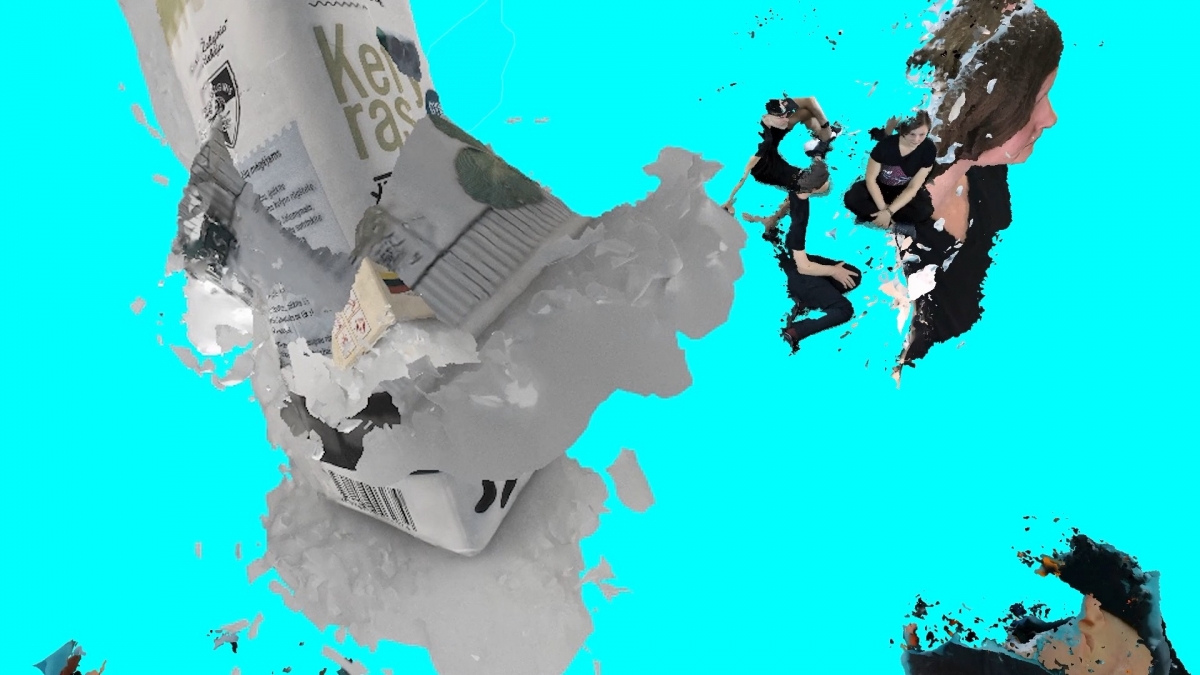An exhibition on our encounters with microorganisms Microorganisms and their hosts by artist Mindaugas Gapševičius will be presented at gallery ‘Atletika’ (Vitebsko 21, Vilnius), opening in the evening on 6 October.
The main theme of this project, this exhibition and this conversation is the dependence of aesthetic perception on the products we consume. The project is looking at how certain consumed products, in this case, selected microorganisms, affect our biota –– the populations of various microorganisms living in the gut, which contribute to the overall well-being of the human body and possibly to aesthetic perception.
In preparation for this exhibition three participants –– artist Mindaugas Gapševičius, scientist Auksė Gaižauskaitė and curator Valentinas Klimašauskas –– are discussing the research for this project.
Valentinas Klimašauskas: Auksė, Mindaugas, what are your roles in this project?
Auksė Gaižauskaitė: I am a specialist in molecular biology and I am responsible for the scientific part of the project: the selection of microorganisms, isolation strategies and the scientific content of the project.
Mindaugas Gapševičius: As an artist, I am interested in aesthetic experiences which change as we get to know the world around us. I explore this project visually in the form of a work of art and raise the question of how we are affected by the microbiota – not just in relation to our senses but also our feelings, actions etc., – and in turn, how we affect the microbiota itself.
V.K.: What is a ‘work of art’ in the context of this exhibition?
M.G.: Aside from the artefacts that are created, a work of art could also be an interactive medium between humans and microorganisms.
V.K.: Interactive medium between humans and microorganisms? But that includes almost all then?
M.G.: In this case we are talking about an interactive medium between very specific organisms, such as human and Lactobacillus bulgaricus or human and Lactobacillus reuteri bacteria.

Mindaugas Gapševičius and Mark Eckstrand producing glass objects for the exhibition
V.K.: How is the selection of microorganisms carried out or which microorganisms are selected and which are not?
A.G.: We first decide which microorganisms will be isolated. Then we examine the scientific literature and information on whether these organisms are cultured in the laboratory. If so, an appropriate specific medium and its components are selected and the isolation work starts.
M.G.: We began by asking a question what kinds of microorganisms constitute yogurt. Another question followed –– whether it was possible to control the microorganisms in yogurt at home and at the same time influence the composition of one’s microbiota while consuming them. Having found out the types of microorganisms which can possibly be isolated at home we realised that there were not so many of those microorganisms.
V.K.: Maybe you could list them?
A.G.: So far, we think that we managed to successfully grow Lactobacillus bulgaricus, Streptococcus thermophilus and Saccharomyces cerevisiae yeasts in the laboratory. We are currently continuing to work with other microorganisms, trying to isolate Leuconostoc bacteria from sauerkraut.
M.G.: We are also considering growing bacteria from purchased probiotics: currently we are preparing Lactobacillus reuteri for growing.
V.K.: What has been proven scientifically in relation to how the bacteria used in this project might change how humans feel and their aesthetic self-awareness?
A.G.: The properties of probiotics, better known as ‘the good bacteria’ have been studied for many years. Our body has its own microbiota –– populations of various microorganisms living in the gut which contribute to the overall well-being of the human body –– they help to break down the food or even regulate the release of certain hormones. Recent research has shown that intestinal bacteria can also indirectly contribute to a person’s emotional well-being and mood management. By purposefully consuming certain products which contain probiotic bacteria we can try to regulate the quantity of probiotics in the body. This statement, however, is more of an assumption than a fact.
V.K.: Auksė, why are you saying that intestinal bacteria can indirectly contribute to emotional well-being and mood management of a human? What is the uncertainty about?
A.G.: Microorganisms which enter the gastrointestinal tract have to travel a long and difficult path to reach the gut and if they remain in good shape by the time they are there, they can ‘settle’ and do ‘the good job’. Gastric juices, digestive enzymes and the entire environment of the gastrointestinal tract are designed to break down food and any living organisms into nutrients, so only a very small percentage of bacteria can survive in such an environment. For these reasons, I use this very cautious phrase ‘can contribute’, because no one knows how many of those organisms survive the journey to the gut, and how many such surviving organisms are able to successfully settle in the competitive gut medium.
V.K.: Suppose if certain ‘good bacteria’ can improve the well-being, empathy, social emotions, then couldn’t we think that bacteria could make us into better humans and at the same time contribute to building a better society?
M.G.: In preparation for this exhibition, we organised several creative workshops to analyse the effects of synthetic oxytocin hormone on our feelings. According to scientific articles, it should be possible to achieve a similar effect by consuming certain types of yoghurt. If everyone agreed to use such yogurt, then our improving microbiota could possibly contribute to a better society as well.
A.G.: As a representative of science, I always try to emphasise that we shouldn’t try to present facts as absolute without knowing the context. When it comes to the potential impact of gut bacteria on the emotional state of humans, we need to understand that these constitute only a small fraction of those factors in our body which control our emotional state. Therefore, when we talk about the regular consumption of some certain kind of bacteria, we only speculate on the possibilities at a high level.

Exhibition objects in the oven
V.K.: Does this mean that you are cautious about potentially the most important questions of the project, which Mindaugas formulated as follows: ‘this project explores how, alongside conventional understandings of sensory experiences, we are affected by changing microbiota and how in turn we influence microbiota’?
M.G.: I suggest we listen to our organisms and watch them change. I can mention, let’s say, our feces: it will be different if we have been eating live yogurt, drinking alcohol or taking antibiotics for a week.
A.G.: We should always be careful about what is not proven, so evaluation should always be critical and balanced. As for the project itself –– Mindaugas is more into asking questions and providing reflections, my goal is to cover them with scientifically proven facts, bringing them closer to reality and trying to fill in the obvious gaps.
V.K.: Would that be the recipe for the success of this project? Given that the link between probiotics and cognitive and behavioural processes involving neurological, metabolic, hormonal and immunological signalling pathways has already been demonstrated, it is not enough for me personally, as a consumer of art and probiotic cultures, that this project promotes only science or art. So, what would be the success of this project for you?
M.G.: In addition to the influence of microbiota on aesthetic perception, I am concerned about the direct involvement of the viewer in the project, the inclusion of new viewer experiences into the artistic value of the work and the dissemination of the concept of art. The more the viewer becomes involved in development of new experiences in art-related activities, the more contemporary art will become relevant.
A.G.: Collaborations between art and science can generate high-quality, meaningful ideas that have value not only to society but also to art or even science. And if we still manage to involve more people in such discussions, to encourage them not only to ask questions, but also to get interested in relevant information, it is a victory for all of us.
V.K.: Thanks for the interview! Let’s watch how the microorganisms we use change us and our society!
This exhibition is realised in collaboration with Auksė Gaižauskaitė (microbiology), Antanas Gerlikas (glass), Laura Kaminskaitė (exhibition design, glass), Valentinas Klimašauskas (curating).
Organised by Institutio Media and the Lithuanian Interdisciplinary Artists’ Association. More information about the events is available on our social media. The project is supported by Lithuanian Council for Culture and Bauhaus University Weimar.

Imaginary yoghurt and human relationship video still

Yoghurt with Streptococcus thermophilus bacteria. Photo: Vilius Vaitiekūnas

Yoghurt from lactobacillus bulgaricus bacteria

Aquarium with lactobacillus bulgaricus bacteria






























